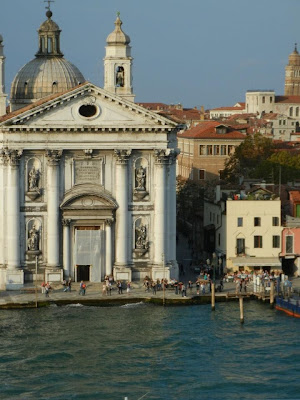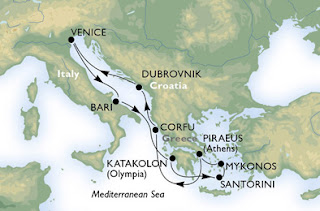Getting There
Venice has both train and air service. By train, Venice is connected to Rome in 3.5 hours and to Milan in 2.5 hours. From our home in Texas, there were no direct flights available, so we were forced to make at least one connection. We chose to make that connection in London. The overnight layover would begin our adjustment to the seven hour time-zone change (see London Connection).Our two hour flight from London to Venice took us over the Alps, and, on arrival, the Venice canals are a spectacular visual introduction from the window of the airplane.
Once we retrieved our baggage, we purchased tickets on the vaporetti from the information counter, which was located adjacent to the baggage claim area. Our route was called "Alilaguna" (translates to "airport boat"). The vaporetti wharf was reached via a 5-minute walk from the airport.
The very scenic boat-ride took about an hour, and cost €15 per person. If you sit on the right hand side of the boat you'll get the best views as you approach the city.
There are many sights to see in Venice, but it is the whole of the city that is interesting. Don't try to dissect the city into parts. You will want to see Piazza San Marco (often known in English as St Mark's Square), but the journey across town is equally as breathtaking.
Venice is a very clean city. Many of the locals have small dogs, but one does not need to watch their step (as in other European cities). This is an ancient city, but very well maintained. (More information on Venice).
We boarded our cruise ship, left Venice at about 5PM, and cruised through the Giudecca Canal. Over the next week, we would stop in at least one new port each day (more information on our cruise ship, the MSC Musica).
Our first stop, on Monday, was Bari, Italy.
Bari (Monday)
Bari is located in Southern Italy, just above where the "heel" begins. Bari is best known as the home of St. Nicholas, and the church that carries his name should not be missed. Bari was already a thriving center when the Romans arrived in the 3rd century B.C.But, compared to other Italian cities, Bari offers less tourist appeal. Bari is a commercial and educational center.
(more information about Bari, Italy). We left Bari at 6PM, and cruised to our second stop in Katakolon, Greece.
Olympia (Tuesday)
Katakolon is a quaint seaside village, but most of the ship's passengers boarded a bus for the 30 minute ride to Olympia, which is the site of the original Olympics. Olympia has been an archeological excavation site since 1875, when German archaeologist Ernst Curtius began his dig. Olympia was the site of the ancient festival of Zeus, and was host to the Olympic games for more than a thousand years (776 BC through AD 393). (more information about Olympia).We left Katakolon at 6:30PM, and cruised to the island of Santorini, Greece.
Santorini (Wednesday morning)
We arrived before 9AM. The port does not have docking facilities suitable for a large cruise ship, so a small fleet of tenders (a boat with a capacity of about 50 passengers) ferried us the quarter mile from the boat to the dock. Most of the town is up a steep hill. A few hearty souls chose the donkey ride, but most took a tram up the hill.Santorini is one of the most popular cruise ship stops in the Mediterranean. Santorini offers a view with sugar-cube houses built onto the high cliffs of Fira's caldera (a volcano crater). This is the Greece of unparalleled vistas and blue-domed churches. (more information about Santorini).
We left Santorini at 2:15PM, and cruised to another small scenic Greek island, Mykonos.
Mykonos (Wednesday evening)
We arrived in Mykonos just before sunset. Fans of the Bourne movies will recognize the island from the opening scenes of The Bourne Identity. Mykonos is a hyper-pleasant island with nice cafes, and shopping in little shops lining winding walkways. (more information about Mykonos).We left Mykonos at midnight, and cruised to Peraeus. Peraeus serves as the port for Athens.
Athens (Thursday)
Athens is one of the world's oldest cities, and is of course, known for its archeological sites, including the Parthenon.Athens can boast of advances in science, medicine, and literature. Doctors take the Hippocratic Oath, founded by a man named Hippocrates who lived in Athens.
Socrates, Plato, and Aristotle developed many philosophical ideas still studied today.
Pythagoras was an early mathematician and is credited with such mathematical theories and formulas as the Pythagorean theorem.
(more information about Athens).
We left Athens at 4PM, and cruised to another Greek island, Corfu.
Corfu (Friday)
We arrived at Corfu about noon the next day. Corfu is called the "green island" because of its 3 million olive trees. It is a beautiful, and very popular Greek resort. (more information about Corfu).We left Corfu at 7PM, and cruised towards Dubrovnik, Croatia. Dubrovnik is an ancient walled city, and also was an important site in the Bosnian Civil War
Dubrovnik (Saturday)
Dubrovnik is a popular tourist stop for cruise ships. The ship arrives about a mile West of the old town. (more information about Dubrovnik).We left Dubrovnik at 7PM, and cruised to our cruise conclusion, back in Venice. Our cruise lasted seven nights, and in addition to Venice, we visited seven ports of call. Unlike many itineraries, our cruise did not include a "day-at-sea".












